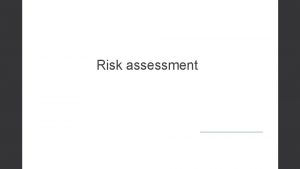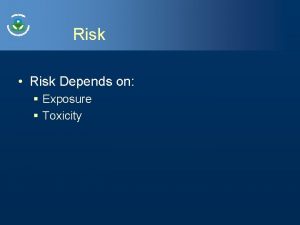Exposure Assessment in the Context of Epidemiological Risk





- Slides: 5

Exposure Assessment in the Context of Epidemiological Risk Analysis J. R. Nuckols, Ph. D Emeritus Professor of Environmental Health Sciences Colorado State University Associate Affiliate Faculty Colorado Water Institute Principal, JRN Environmental Health Sciences, Ltd. North Bethesda, Maryland, USA jnuckols@colostate. edu Ph 970. 218. 4757 Fx 301. 560. 8589

ENVIRONMENTAL HEALTH ADVANCED SYSTEMS LABORATORY EST 1992 MISSION: IMPROVE EXPOSURE ASSESSMENT ENVIRONMENTAL EPIDEMIOLOGY BYPRODUCTS OF WATER DISINFECTION NON-OCCUPATIONAL CHEMICAL EXPOSURE APPLICATION OF GEOGRAPHIC INFORMATION SYSTEMS

“By its very nature, environmental epidemiology requires integration of health, earth, engineering, and mathematical sciences…” • RISK • ENVIRONMENTAL EPIDEMILOGY • CONTAMINANT

My Specific Focus: IWSI Symposium • Cumulative Risk: Where there is nutrient enrichment of surface and groundwaters, there are usually companion contaminants associated with the source. • Cumulative Impact: Degraded water resources result in increase health care costs and diminished quality of life. – increased prevalence of waterborne contaminant exposure and disease – lack of access to healthy environments for recreational purposes – fouling of prime agricultural and natural lands (reducing production, increasing pesticide use and/or ecological exposure) – Exposure to toxic pass through or secondary contaminants in “finished” water supply by conventional treatment. • Prevention: Source protection by far the most effective and efficient means of reducing ecologic, economic, and societal costs. • Advocate: Implementation of the Clean Water Rule (FR 80 -124, June 29, 2015) as extension of the Clean Water Act (CWA)

Drinking water nitrate and health • MCL of 10 mg/L NO 3 -N (~44 mg/L NO 3) based on methemoglobinemia in infants • Ingested nitrate can form N-nitroso compounds – Most are carcinogenic and teratogen • Nitrate also inhibits iodine uptake by the thyroid • Epidemiologic studies - strongest evidence for: – Thyroid disease (hypothyroidism) – Colorectal cancer – Neural tube defects Source: Ward et al. Int J Environ Res Public Health 2018








